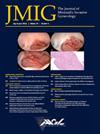The Trifecta: A Spill-Free, Fertility Sparing, Minimally Invasive Approach for a Large Adnexal Mass
IF 3.5
2区 医学
Q1 OBSTETRICS & GYNECOLOGY
引用次数: 0
Abstract
Study Objective
Demonstrate the safety and feasibility of laparoscopic-assisted extracorporeal ovarian cystectomy of a large benign adnexal mass. To exhibit spillage-free drainage methods in management of a large adnexal mass aligning with the goal of fertility-preservation in a patient with previous unilateral oophorectomy.
Design
Case presentation.
Setting
A university hospital.
Patients or Participants
31-yo G1P1001 with history of right oophorectomy presenting with abdominal pain/fullness, heartburn, and SOB. CT-A/P finding of a 24 cm adnexal mass described as multiloculated, mainly cystic with solid components that contain fat and calcification. Tumor markers were negative.
Interventions
Laparoscopic-assisted extracorporeal ovarian cystectomy of 24-cm adnexal mass by spill-free drainage techniques and fertility sparing intervention with reconstruction of the remaining left ovary.
Measurements and Main Results
The laparoscopic-assisted extracorporeal ovarian cystectomy was completed without complications including spillage with an EBL of 100 cc. The pathology confirmed a cystic mature teratoma. At post-operative follow-up in two weeks and six weeks, the patient was doing well without concerns with plans for pregnancy in the following year.
Conclusion
Laparoscopic-assisted extracorporeal ovarian cystectomy is a safe and minimally invasive approach for removal of large benign adnexal masses. The technique displayed in this video shows a spill-free drainage method for management of large adnexal masses by a minimally invasive approach.
三连胜: 无溢液、少生育、微创法治疗巨大附件包块
研究目的展示腹腔镜辅助体外卵巢囊肿切除术治疗巨大良性附件包块的安全性和可行性。患者或参与者31 岁,G1P1001,有右侧输卵管切除术史,表现为腹痛/腹胀、胃灼热和 SOB。CT-A/P发现一个24厘米的附件肿块,描述为多发病灶,主要为囊性,含有脂肪和钙化的实性成分。干预措施腹腔镜辅助体外卵巢囊肿切除术通过无溢液引流技术切除了24厘米的附件包块,并通过重建剩余的左侧卵巢进行了生育间隔干预。病理证实为囊性成熟畸胎瘤。结论腹腔镜辅助体外卵巢囊肿切除术是一种安全的微创方法,可用于切除大的良性附件肿块。本视频中展示的技术是通过微创方法处理大型附件肿块的一种无溢出引流方法。
本文章由计算机程序翻译,如有差异,请以英文原文为准。
求助全文
约1分钟内获得全文
求助全文
来源期刊
CiteScore
5.00
自引率
7.30%
发文量
272
审稿时长
37 days
期刊介绍:
The Journal of Minimally Invasive Gynecology, formerly titled The Journal of the American Association of Gynecologic Laparoscopists, is an international clinical forum for the exchange and dissemination of ideas, findings and techniques relevant to gynecologic endoscopy and other minimally invasive procedures. The Journal, which presents research, clinical opinions and case reports from the brightest minds in gynecologic surgery, is an authoritative source informing practicing physicians of the latest, cutting-edge developments occurring in this emerging field.

 求助内容:
求助内容: 应助结果提醒方式:
应助结果提醒方式:


